03
 Build a smart octopus drumbot that listens, learns, and plays along with you
Build a smart octopus drumbot that listens, learns, and plays along with you
The post Dr. Squiggles: An AI Rhythm Robot appeared first on Make: DIY Projects and Ideas for Makers.
 Build a smart octopus drumbot that listens, learns, and plays along with you
Build a smart octopus drumbot that listens, learns, and plays along with you
The post Dr. Squiggles: An AI Rhythm Robot appeared first on Make: DIY Projects and Ideas for Makers.
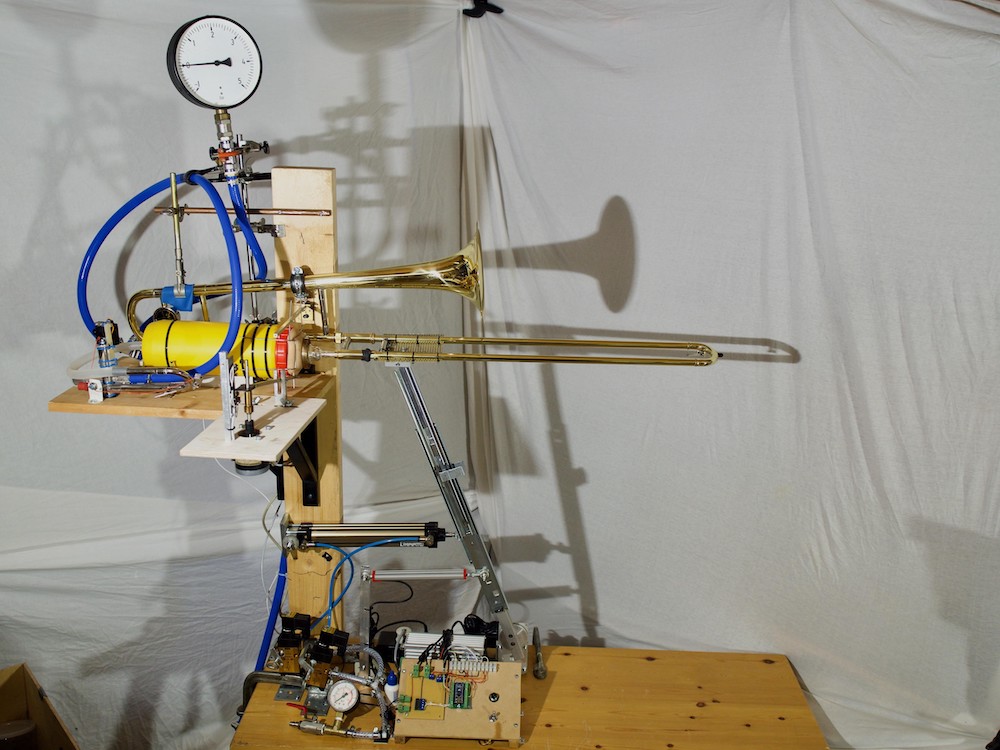
Inspired by Wintergatan’s Martin Molin, iSax set out to create a MIDi-controlled robotic trombone of his own. Although the aptly named RoboTrombo may not replace professional trombone players any time soon, it’s nonetheless an impressive musical hack.
The instrument is controlled by an Arduino Nano running Firmata, along with a host computer, and employs a variety of pneumatic and electrical actuators to produce the tunes.
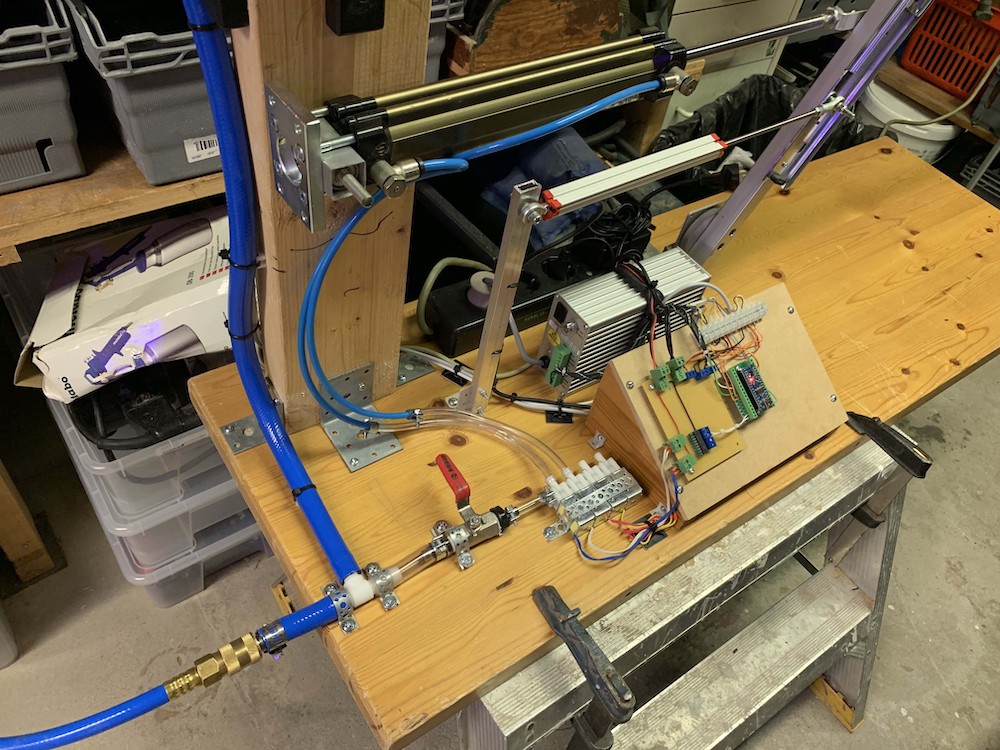
When played, air flows through the mouthpiece via artificial lips, and turned on and off with a trumpet valve and servo. The lips can be manipulated for different sounds using a stepper motor setup. A slide mechanism is driven by a pneumatic actuator, with a linkage system that pushes it in an out, and a potentiometer provides positional feedback.
While it can’t reliably play songs on command, it’s a very entertaining project that makes a bunch of fun semi-random noises! More details on the design and construction of the RoboTrombo can be found in PDF form on iSax’s Hackaday page.
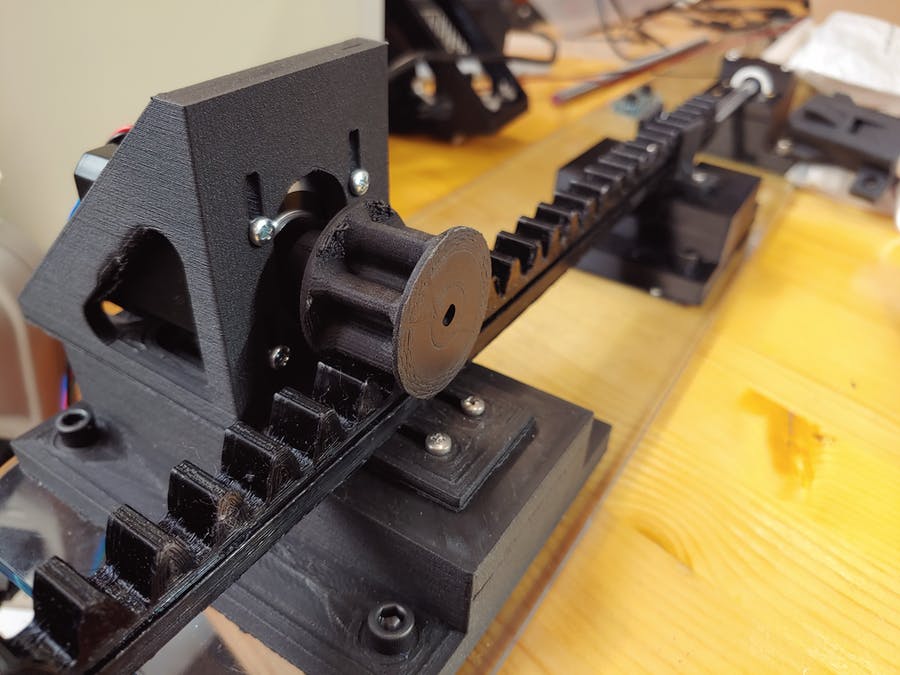
Slide whistles and recorders can be great for learning music, and perhaps a bit of fun, but what about teaching a robot to play such a wind instrument? The Mixed Signal’s MIDI-controlled system could used for just that.
The project is comprised of a 3D-printed fipple and piston that go into a PVC tube, while air input is via a centrifugal blower fan. A plunger with a rack-and-pinion gear are used to move the piston back and forth, changing the note being played.

A keyboard provides the user interface here, though any number of digital audio workstation devices should be able to duplicate this human task if needed. It’s hooked up to an Arduino Due with a CNC shield, which controls the single stepper motor.
You can find more details on the fipple flute on Hackster and Hackaday, and see a demo of it in action below.
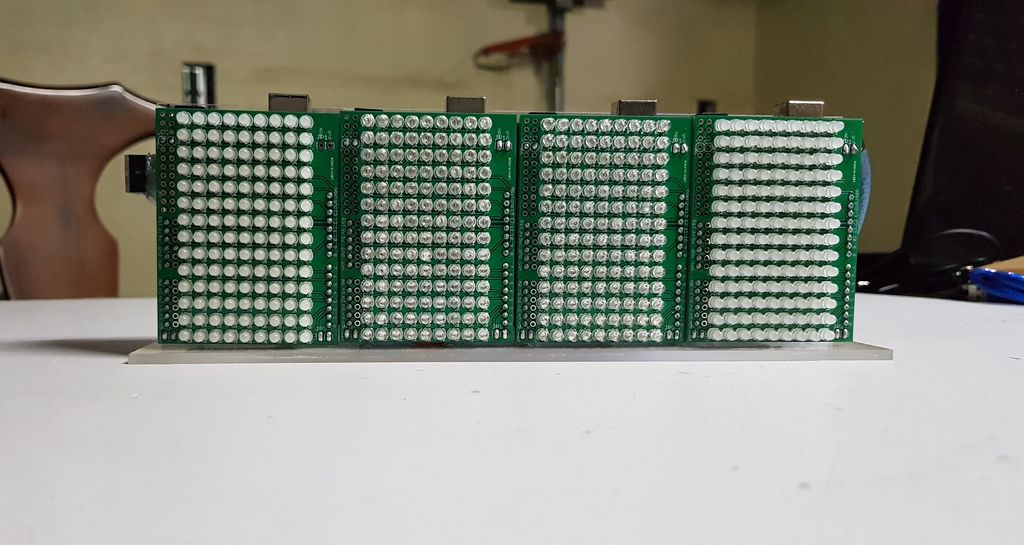
Spectrum analyzers are a great way to visualize music, and “TUENHIDIY” came up with an interesting take on this device using not one, but four Arduino Uno boards.
Each Uno receives the same sound input via a 3.5mm audio jack, and separately processes it to break out the left and right channels, as well as upper and lower frequency ranges using fast Fourier transforms, or FFTs.

36 different bands are shown on four LoL Shields, with each 9×14 Charliexplexed LED matrix attached to an Uno, for a total of up to 504 individual points of light. Everything is put together on an acrylic plate, and powered by a portable USB battery.
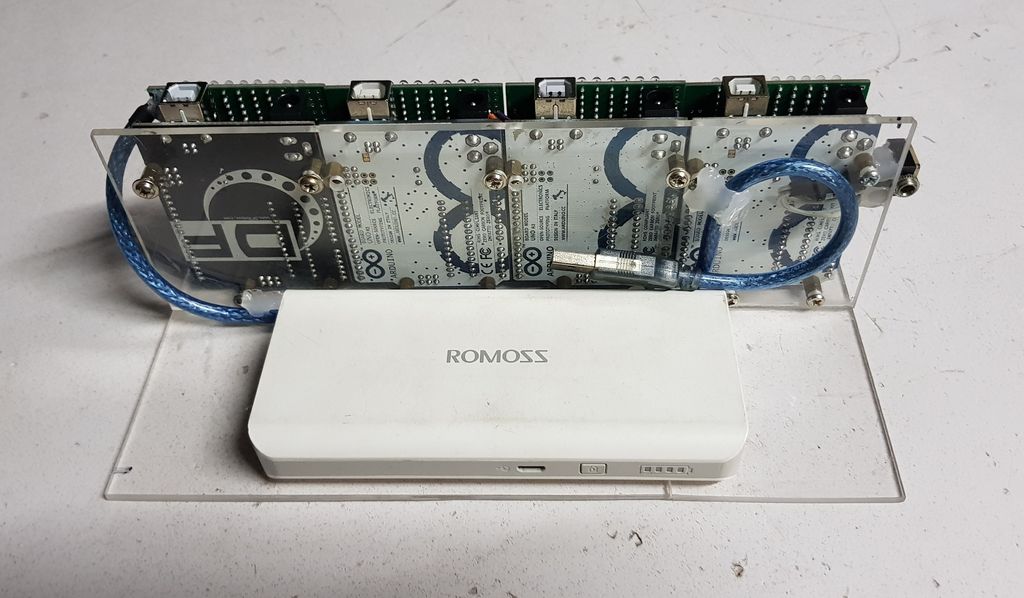
TUENHIDIY is quick to note that it’s a “crazy project,” but as seen in the video below, it looks like a lot of fun!

Max Danilin created an automatic barrel piano that outputs MIDI signals, not through an SD card or internal memory, but by reading sheet music encoded on paper as black dots and dashes.
The paper is pulled under an array of 40 optocouplers using a hand crank — or even power drill — providing musical info to the device’s controlling MKR Zero board. These inputs are translated into USB MIDI, which can then be passed along to any synthesizer for a wide range of audio output.
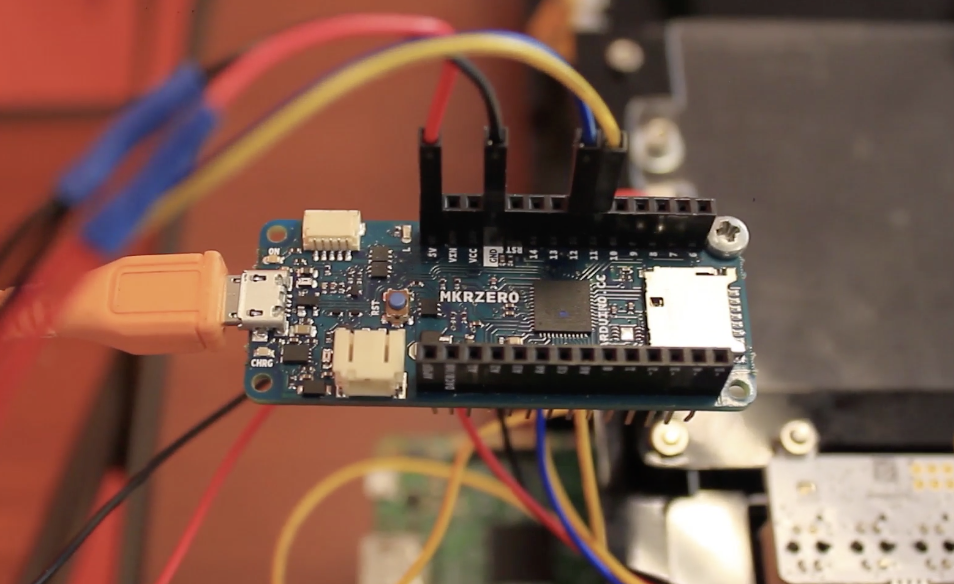
The electronics and paper feed mechanism are put together in an elegantly simple way, and it appears to work quite well in the video below. In fact, it can even be played while mobile via casters on the bottom of its stand!

Vintage typewriters are truly amazing pieces of technology, but unlike modern keyboards, they are decidedly one-purpose machines. William Sun Petrus, however, had other ideas for his 1920s-era Remington Portable typewriter, augmenting hammers with wires as inputs to an Arduino Mega.
Input signals are produced when each key strikes a metallic “live plate” in the center, completing a circuit. This info is passed along as MIDI signals to a computer running Ableton digital audio software, allowing him to create the excellent beat seen in the video below.
Typewriter code is available on GitHub, where you’ll certainly notice the lines from Green Eggs and Ham that are output on an LCD screen at the base of the almost 100-year-old device.

Frank Piesik recently designed a robotic three-stringed instrument for his friend, Gregor, that features a unique sound and mechanical arrangement. Notes are selected by an array of 12 servos — four for each string — which pull down using a loop mechanism.
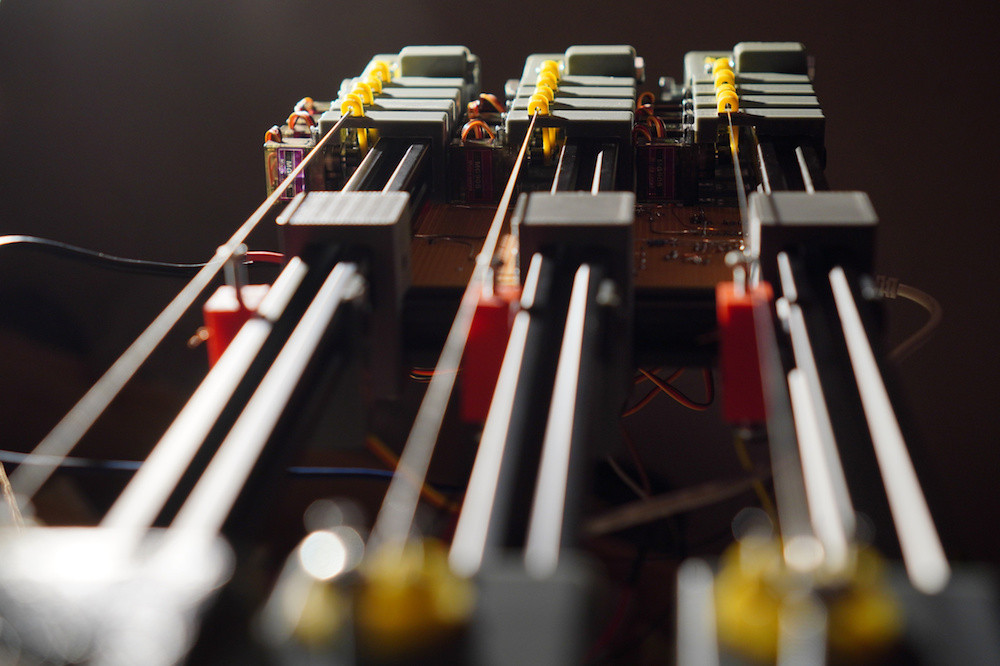
The aptly named Greg’s Harp is played by a solenoid-driven “KickUp” device that hits it from below and a small motor that continuously swipes with a “tape-propeller.” A coil assembly is also implemented to give the notes the ability to keep ringing for as long as needed (infinite sustain).
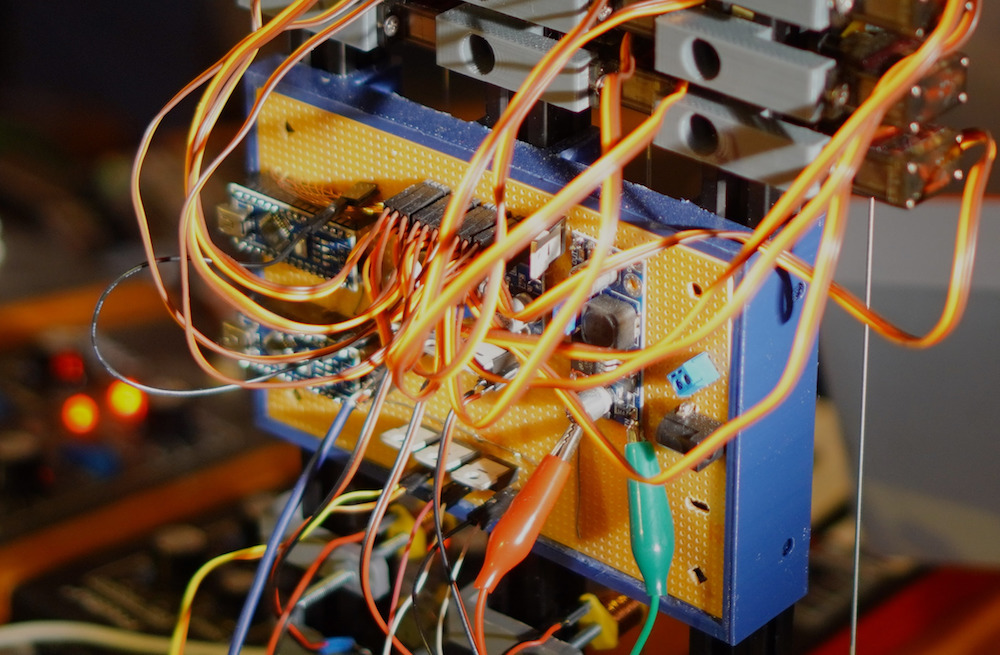
Everything is controlled by pair of Arduino Nano boards, which allow for the large number of outputs needed here, along with a Teensy 3.2 for audio processing and MIDI capabilities. You can see and hear this amazing project in the video below and more info is available in Piesik’s blog post.

Frank Piesik recently designed a robotic three-stringed instrument for his friend, Gregor, that features a unique sound and mechanical arrangement. Notes are selected by an array of 12 servos — four for each string — which pull down using a loop mechanism.

The aptly named Greg’s Harp is played by a solenoid-driven “KickUp” device that hits it from below and a small motor that continuously swipes with a “tape-propeller.” A coil assembly is also implemented to give the notes the ability to keep ringing for as long as needed (infinite sustain).

Everything is controlled by pair of Arduino Nano boards, which allow for the large number of outputs needed here, along with a Teensy 3.2 for audio processing and MIDI capabilities. You can see and hear this amazing project in the video below and more info is available in Piesik’s blog post.
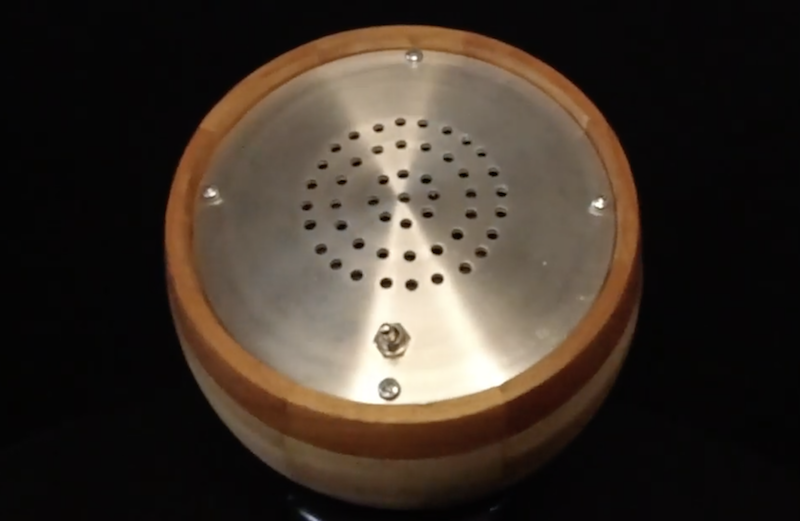
Some years ago, Emily Velasco started exploring the idea of creating a musical instrument based on a pendulum. This didn’t work out exactly the way she’d planned, but after several iterations — and inspiration from a cat toy — the device eventually turned into a sort of wobbling egg-shaped instrument, which sings as it tilts and tumbles.
The Orb — as seen and heard in the video below — is truly strange, reminiscent of a theremin morphed with a trendy bowl-shaped wooden speaker.

As it’s spun, the Orb produces a sort of warbling noise, and one can position it to vary the sound by hand if they so desire. Inside lies an Arduino Nano running the Mozzi audio synthesis library, along with an accelerometer and audio amplifier board.
It’s one thing to be able to transcribe music from a flute, and it’s another to be able to make a flute play pre-written music. The latter is what [Abhilash Patel] decided to pursue in the flute player machine, an Arduino-based project that uses an air flow mechanism and PVC pipes to control the notes produced by a makeshift flute. It’s currently able to play 17 notes, just over two octaves starting from the lowest frequency of E.
In order to play songs, the tones have to either be directly coded and uploaded to the Arduino, composed with a random note generator, or detected from a microphone. While a real flute can be used for the machine, [Patel] uses a PVC flute, constructed with some knowledge of flute playing.
The resonant frequency is based on the effective length, hole sizes, and pipe diameter, so it is fairly difficult to correctly tune a homemade flute. Nevertheless, calculating the length as c/2f where c is the speed of sound (~345 m/s) and f is the frequency of the note can help with identifying the location of the holes. [Patel] cut the PVC pipe and sealed off one end, drilling a blowing hole at 1.5 x the pipe diameter. After playing the flute, the end of the pipe was filled until the frequency exactly matched the desired note.
The hole covering uses cuttings of pipe attached to a cable connecting to a servo. The motors are isolated inside a box to keep the wires clear and area all able to be powered with 5 V. As for the software, the code is primarily used to control when the fan is blowing and which holes are covered to produce a note.
Listen to the flute play “My Heart Will Go On” from Titanic in the video below. Now the next step might just be making the flute playing machine automatically play sheet music – imagine the possibilities!